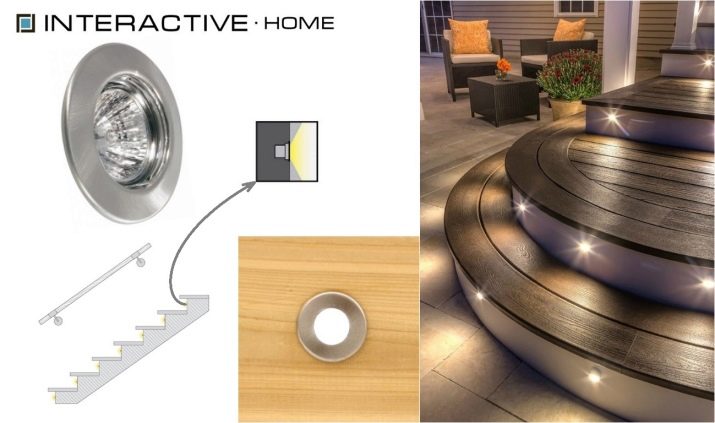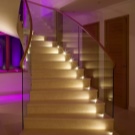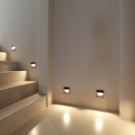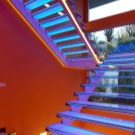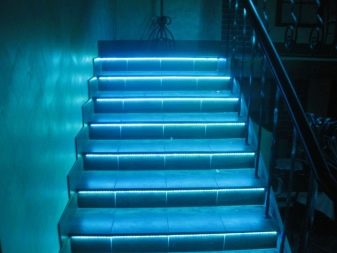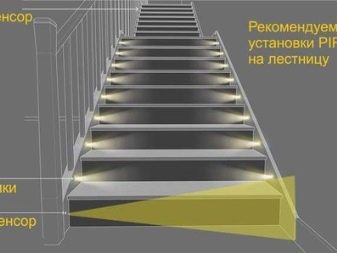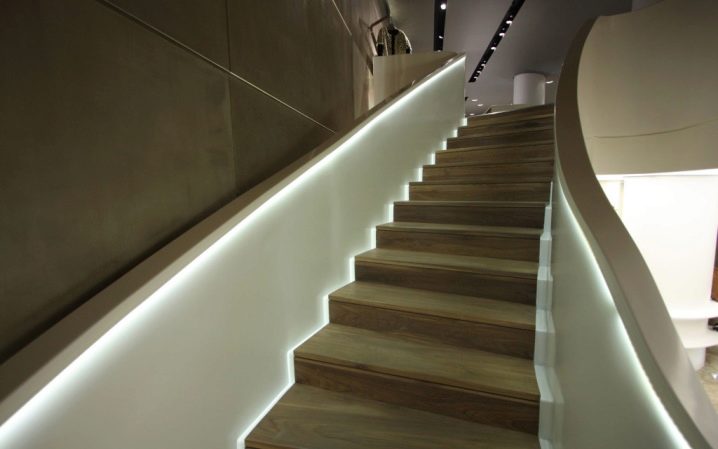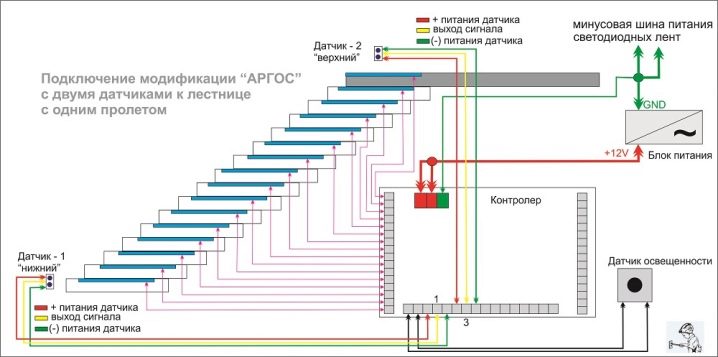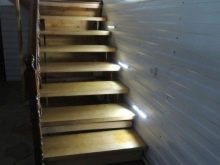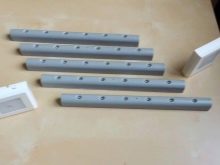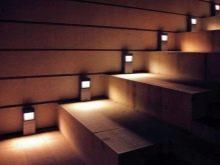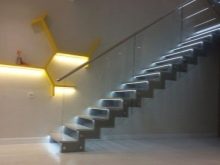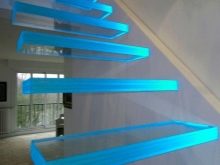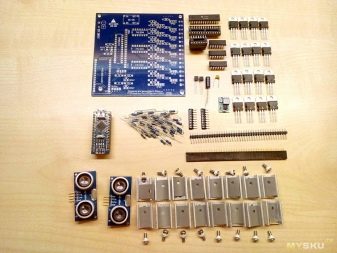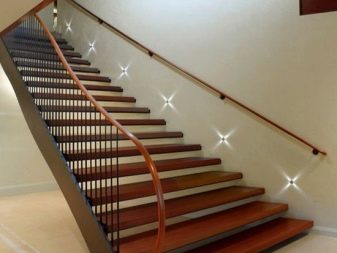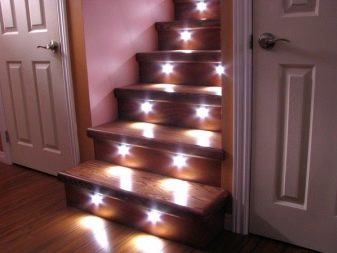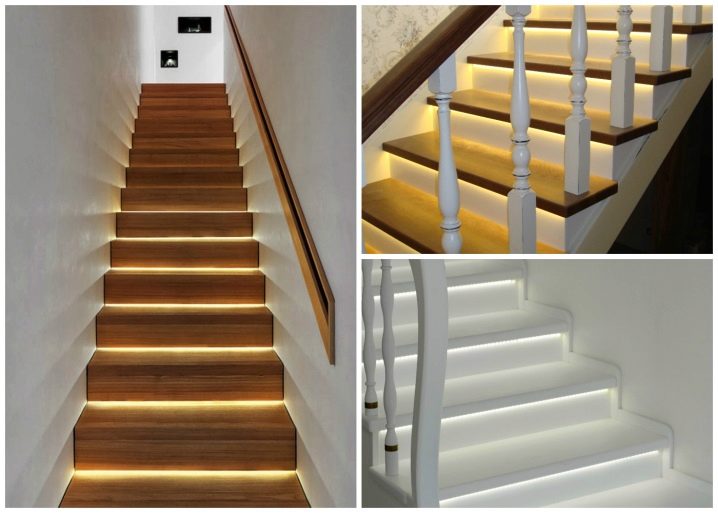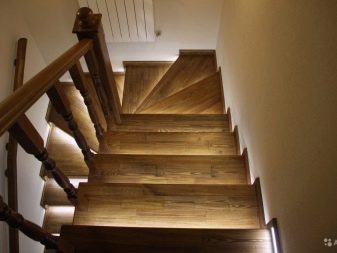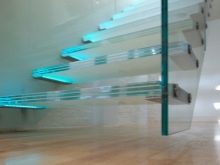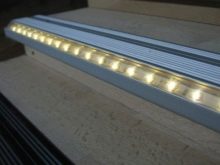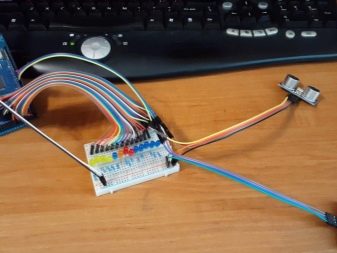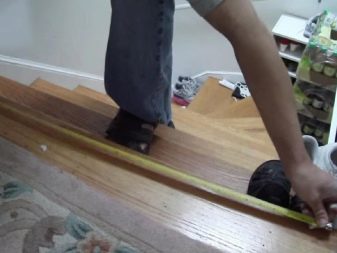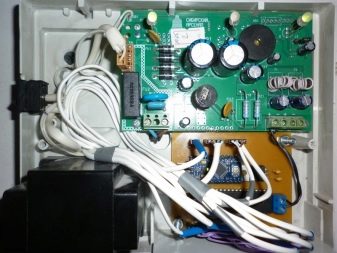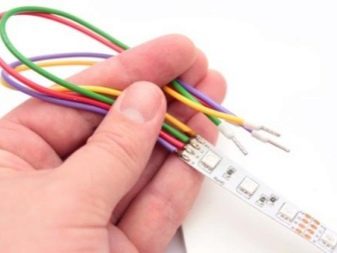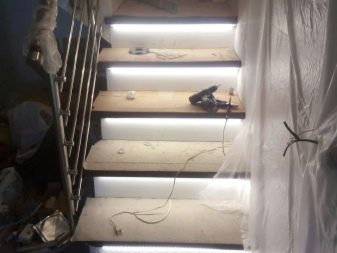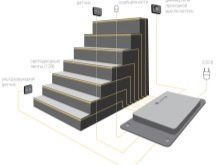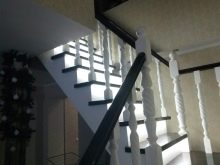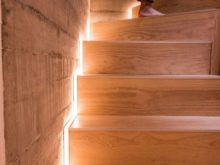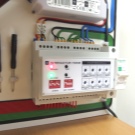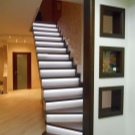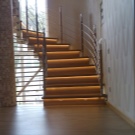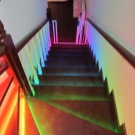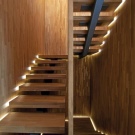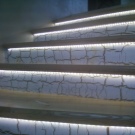Automatic staircase lighting: how does it work?
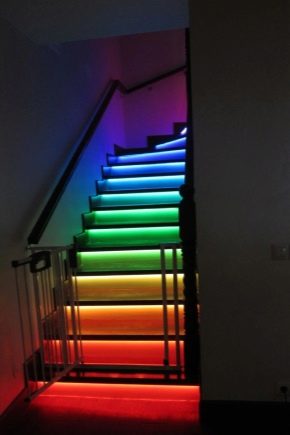
This article will be interesting and useful to those who decided to make their home original, decorating the stairs in it with the help of automatic lighting. This way you can also increase the level of security, which is important if you have small children or elderly people in your home. It is possible to decorate with illumination the stairs of a private house, located both outside and inside.
How does automation work?
Necessary devices for the operation of the automatic backlight: controller, motion sensor, light sensor (if you wish), cable.
There are sensors that can respond to different types of “stimuli”, for example voice, clap, movement. You can install them in any convenient place, near the first and last stage.Sensors are connected to the controller - the basis of the whole structure, they are informed about the necessary command, and the controller transmits this information to the switch.
There are also timers with which you can set the desired on time. If someone returns home late, it will be very useful. There is a possibility to adjust the lighting, its intensity, smoothness of switching on, brightness, alternate switching on of each individual stage.
It is appropriate to connect a light sensor to save energy. With it, the backlight will automatically turn off or not turn on at all during the daytime.
It must be installed in places where the change to light and the shadow passes more clearly, therefore, the command will be given exactly at the right time.
The smart mechanism works like this:
- When approaching a stage, or direct contact with it, response sensors are triggered, a command is given to the controller, and the staircase is illuminated.
- After a certain time, the light goes out.
- During daylight and when passing by the sensors, the light will not light up if the settings are correct.
- Note that if there are pets in the house, the sensors will react to them.
This is a very economical option for energy consumption. Set this kind of lighting can be both in the house and on the street stairs. In the latter case, it is worth considering that there often changes the temperature and humidity. The material of the staircase is also important. All these nuances can create installation problems.
For long and spiral staircases, it is appropriate to adjust the alternate lighting of each stage.
Work sensors, can be carried out from wireless sources, power. It is very convenient, fast, economical and safe. No need to install the walls, and you can avoid the problems of double repair. They already have all the necessary devices, settings have been made, there are instructions, their installation does not require special training.
You can also make wiring from the main electrical network. This option will take more time and effort if the owner himself decided to do it. But you have to spend more money if you hire an electrician.
The advantage of automatic backlighting is that it saves time because there is no need to look for a switch in the dark. Savings occur because the backlight does not work all the time and turns off on its own; it also contributes to additional security for the oldest and youngest family members. And it looks very original.
Types of lighting
There are several types of lighting:
- Lateral. It is mounted on the wall opposite the stairs. You can use separate sconces or lamps with directional lighting. Sometimes it is appropriate to apply the railings at the same time.
- Top - The main lighting on the ceiling. If there is enough space above the staircase, then a chandelier is perfect, it will cover more space with its light. In the case of a spiral staircase, if there is space, you can use long chandeliers as an independent light. You can install additional spot LED lamps to the chandelier, and turn them on independently of each other.
- Bottom. It looks very nicely masked in the steps or between them the built-in devices - tape and tube LEDs. To install them do not need to hammer walls, the process will take less time.
- Separate spotlights with grilles can be placed in the wall opposite the steps.They are also not particularly difficult to install, there is a variant of products attached and working from a battery.
- Mixed. The use of several types at the same time is an option for the manifestation of fantasy, but it requires considerable expenses. The lighting of the steps and the railing, the upper chandelier with side or floor lamps perfectly combines perfectly. The main thing here is to pick up the harmonious light of the lamps themselves, it should be remembered about safety, all the steps should be illuminated without distorting the shape.
There are several types of instrument lamps:
- Neon. They have a soft light and do not give shadows, which is very important for safety. They shine for a long time, but are subject to damage.
- Halogen. Like previous lamps, they are good with their soft and diffused light, although they are brighter. Devices can quickly burn out, they are also sensitive to power surges.
- LED light. Often used LED strip. Such sources of lighting are durable, they can also work on batteries, do not heat up, have different colors.
Today, the Arduino ladder lamp, which is notable for its high quality, is quite popular.
Equipment: types and selection
For lighting, the following lights are used:
- Spotlights and chandeliers with chandeliers. This option is suitable for top and side lighting. Lamps can be both built-in and overhead, working on batteries. Wall-mounted devices are mounted at the same level from the steps, they should be located not less than two meters from the steps.
LED bulbs are suitable as light bulbs for greater energy savings.
In these cases, it is not necessary to have a special controller, you can use ordinary switches or install a single switch common to all lamps. When choosing this type of backlight, remote control of lighting with a remote control is relevant.
For the installation of these light devices, it is necessary to arrange the wiring from the central network on the ceiling and walls to the fixing point of the device, to hide the wires in the walls, boxes. Naturally, you need to open the walls or ceiling, build a switch, sometimes you have to carry the cable through the attic.
- Optical fibers, LED tapes and tubes have a bright light and a larger coverage area.They are flexible and durable, the tapes are resistant to mechanical damage, they are cost effective and easy to use. You can use separate LED lamps with gratings, they are also economical and not difficult to install. But the effect of them is just fascinating. There are options for colorful ribbons.
This option is suitable for lower lighting, lighting between the stairs or built into the steps at the edge of the rim. You can glue the tape on the railing for additional lighting.
The choice of equipment depends on the place of its intended installation, the design of the stairs and the room, the preferences of the owners and their financial possibilities.
The easiest way is to install tapes with LEDs. You do not need to dismantle the walls and buy a lot of tools. Consequently, the funds can be spent less. LEDs have an adhesive base, for greater reliability of construction, double-sided tape or screws are used. When choosing this type of tinting, remember that the whole staircase and each step should be illuminated without distorting the shapes.
The choice of devices and lighting depends on the material and type of the staircase itself. The following are common types of raw materials for ladder designs:
- Wooden stairs. The risk of their ignition is taken into account, they require lighting devices, the lamps of which should not be heated very much, and good insulation is also needed. The surface itself should be treated with materials to increase the resistance to temperature changes. It is possible to use either a ribbon, or luminaires with a grille built into the steps or a wall.
- Metallic. It should be noted that the metal conducts well, the wiring must be carefully insulated. You can apply overhead lights. In this case, it is better to choose lamps or sconces on the walls or ceiling.
- Spiral stairs. They are most often designated with a tape, it is flexible and durable and easily takes the necessary shape. It looks good and on the steps themselves, as well as glued to the railing or wall. If there is enough space, install a long suspension chandelier, the body of which goes down and illuminates the entire span.
- Glass stairs. Here the LED strip will suit, the light will give the construction of weightlessness and originality. You can get a glow effect from the inside. And if design and construction allows,it is possible to mount spotlights under the stairs, create the necessary luminescence of all the steps, while the devices are protected from damage.
- Concrete. Sconces or lamps are embedded in the wall, or mounted tape with aluminum profiles.
Preparation: Planning
Planning will take a little time, the main thing is to determine the layout and installation location of the selected equipment, the required long cables, the location and method of masking the wiring. Before you start, you need to stock up with everything you need to install.
To embed a chandelier or lamp, special tools are needed: a drill, pliers, electrical tape, screwdrivers. Independent cable removal, installation of wiring, connection of switches - work is long and even dangerous for beginners.
Work on electrical installation requires great care. It is necessary:
- work only when the common power supply is disconnected;
- correctly select the cross-section to the wires;
- isolate all contacts;
- check the polarity.
With insufficient knowledge of the device and the lack of practice, it is better to provide work to specialists.
If you choose the LED strip, you need to buy a set of tools consisting of a screwdriver, a drill, and self-tapping screws. If your ladder does not have a plumb line, all this is useful for installing the tape. Clamps or cable channels are also required. Neon tubes of required dimensions and ducts as an additional level of protection against moisture must also be installed as additional functions.
With your own hands, you can easily mount the LED strip for illumination, following the scheme:
- At first it is necessary to take measurements and cut off the necessary amount of tape, the cutting lines are indicated.
- Further it is necessary to latch on both sides of the device of short circuit. If you solder the contacts, they may last longer, but this procedure will take additional time.
- Degrease the surface and attach the tapes or insert them into the grooves of the profile for additional protection. The wires lead up behind the steps or into the holes between the wall and the stairs. If the design allows, then the cable channels just start along the stairs.
- Install motion-sensing sensors near the top and bottom stairs.
- Wiring from the sensors need to hide behind the steps or lead into the holes in the wall, you can spend it in boxes on the walls.
- Cables are fixed with cable ties or cable channels.
- The system control box must be attached in a convenient place.
- The wires should be connected to the switch and connect everything to the controller, which will control all actions. It needs to be configured using a computer.
- After being checked for readiness for work.
Installation and connection
As mentioned, it is easiest and less expensive to mount the LED strip as a backlight. If this type of lighting is chosen, then after the above stages of its mounting and conducting wires It is important to correctly connect the backlight automation itself:
- Select the place where the box with the controller will be mounted. If possible, it is better to install it under the stairs, the wiring will go less.
- Next, the wiring from each stage lead to the mounting box.
- Connect the motion sensors to the appropriate sockets.
- Connect a light sensor, if available.
- Install the controller in the installation box and connect all the wires to the sockets of the control unit.
- Check the wiring is correct.
- Connect everything to the power supply.
- Make the settings.
Now you need to properly configure the backlight system, guided by their own preferences and taking into account security measures.
The system setup procedure:
- The number of steps that will be highlighted is selected; in the case of a spiral staircase, it is better to illuminate all the steps completely.
- Sets the order of lighting: from top to bottom or vice versa. Steps can be illuminated through one or evenly.
- An ambient light sensor is being adjusted so that the light will illuminate only at a certain level of illumination.
- The range of motion sensors is adjusted so that the steps do not turn on when they are passed by.
- Brightness is adjusted depending on the material and type of stairs.
- After you set the speed of the glow.
Having studied all the above in the article, we can conclude that it is not as difficult to make installation of automatic lighting with your own hands as it may seem.
The main thing is to choose the right lighting devices depending on preferences and compatibility with the interior.And also important is a method that will be easier to implement.
For information on how to make the lights of the stairs do it yourself, see the video below.
